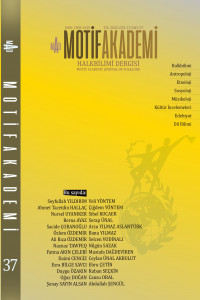Öz
Ergenekon Efsanesi, Türklerin yeniden türeyişinin anlatıldığı efsane metinlerinden biridir. Yurtlarından olmuş bir topluluğun korunaklı bir yer bularak soylarının türediği mekâna Ergenekon adı verilmiştir. Ergenekon’da yeniden çoğalan Türk soyunun mekâna sığamamasıyla bu mekândan çıkış sırasında cereyan eden olaylar kültürel bellek içerisinde muhafaza edilerek kendilerinden sonra gelen nesillere aktarılmıştır. Sonraki nesiller tarafından Ergenekon adlı mekân, yeniden türeyişin hatırlandığı ve mekândan çıkışın kutlandığı bir bayram hâline gelmiştir. Çalışmada Dursun Yıldırım’ın ‘[Ergene Kon] = [Erkin Kün] mü?’ isimli yazısından hareketle efsane metninin topluluk açısından işlevleri üzerinde durulmuştur. [Erkin Kün] şeklindeki okuma önerisi ile bellek sanatının, hatırlama figürlerinden yararlanılarak topluluk için atalar mağarası bağlamında ölülerin anılması, mekân adlandırılması, zaman bakımından ‘kurtuluş günü bayramı’ olarak kutlanması ve törenler boyutunda canlandırma-tekrarlama yoluyla kimlik/aidiyet noktasındaki işlevleri açıklanmıştır. Bu bağlamda efsane metninde yer alan mekânın adlandırılışının mekânda cereyan eden olayların içeriğine de vurgu yaptığı görülmüştür. Efsane metninin, farklı okuma önerisiyle ‘çok işlevli ve çok bağlamlı’ muhteviyat özelliklerine sahip olduğu sonucuna ulaşılmıştır.
Anahtar Kelimeler
Kaynakça
- Assmann, J. (2018). Kültürel bellek eski yüksek kültürlerde yazı, hatırlama ve politik kimlik. (Çev.: Ayşe Tekin), İstanbul: Ayrıntı.
- Connerton, P. (2012). Modernite nasıl unutturur?. (Çev.: Kübra Kelebekoğlu), İstanbul: Sel.
- Ercilasun, A. B. (1985). Ergenekon destanı. Başlangıcından Günümüze Kadar Büyük Türk Klâsikleri Tarih- Antoloji- Ansiklopedi, 1, 53-54, İstanbul: Ötüken-Söğüt.
- Halbwachs, M. (2016). Hafızanın toplumsal çerçeveleri. (Çev.: Büşra Uçar), Ankara: Heretik.
- Halbwachs, M. (2018). Kolektif bellek. (Çev.: Zuhal Karagöz), İstanbul: Pinhan.
- Ögel, B. (2003). Türk mitolojisi (kaynakları ve açıklamaları ile destanlar) I, Ankara: Türk Tarih Kurumu.
- Görkem, İ. (2009). Dünden bugüne ‘Türk sözel edebiyatı’ değişim ve dönüşüm. A. Ü. Türkiyat Araştırmaları Enstitüsü Dergisi Prof. Dr. Hüseyin Ayan Özel Sayısı, 39, 411-422.
- Lefebvre, H. (2016). Mekânın üretimi. (Çev.: Işık Ergüden), İstanbul: Sel.
- Nora, P. (2006). Hafıza mekânları. (Çev.: Mehmet Emin Özcan), Ankara: Dost Kitabevi.
- Ricoeur, P. (2012). Hafıza, tarih, unutuş. (Çev.: M. Emin Özcan), İstanbul: Metis.
- Olick, J. K. (2014). Kolektif bellek: iki farklı kültür. (Çev.: Meral Güneşdoğmuş), Moment Dergi Hacettepe Üniversitesi İletişim Fakültesi Kültürel Çalışmalar Dergisi, 1 (2), 175-211.
- Yıldırım, D. (1997). [Ergene Kon] = [Erkin Kün] mü?. Türk Dili Araştırmaları Yıllığı-Belleten, 45 (1997), 61-149.
- URL-1: https://www.tudev.org.tr/1-turk-kurultayi-21-23-mart-1993-antalya/ (Erişim: 10.01.2022).
Öz
The Ergenekon Legend is one of the legendary texts about the rebirth of the Turks. The place where a community who had been displaced from their homeland found a sheltered place and rebirth, was named Ergenekon. Since the progeny that birth in Ergenekon could not fit into the space, the events that took place during the exit from this place were preserved in the cultural memory and transferred to the next generations. By the next generations, the place called Ergenekon has become a festivity in which the descent inside is remembered and the exit from this place is celebrated. In this study, the functions of the legend text in terms of the community were emphasized, based on Dursun Yıldırım's article named "[Ergene Kon] = [Erkin Kün] mü?". With the reading suggestion in the form of [Erkin Kün], the functions of the memory at the point of identity/belonging are explained by making use of the figures of remembrance, commemorating the dead in the context of the ancestors cave, naming the place, celebrating it as a 'liberation day festivity’ in terms of time, and repetition in the dimension of ceremonies. In this context, it has been seen that the naming of the place in the legend text also emphasizes the content of the events taking place in the space. It has been concluded that the text of the legend with the reading suggestion has the characteristics of 'multifunctional and multi-context'.
Anahtar Kelimeler
Kaynakça
- Assmann, J. (2018). Kültürel bellek eski yüksek kültürlerde yazı, hatırlama ve politik kimlik. (Çev.: Ayşe Tekin), İstanbul: Ayrıntı.
- Connerton, P. (2012). Modernite nasıl unutturur?. (Çev.: Kübra Kelebekoğlu), İstanbul: Sel.
- Ercilasun, A. B. (1985). Ergenekon destanı. Başlangıcından Günümüze Kadar Büyük Türk Klâsikleri Tarih- Antoloji- Ansiklopedi, 1, 53-54, İstanbul: Ötüken-Söğüt.
- Halbwachs, M. (2016). Hafızanın toplumsal çerçeveleri. (Çev.: Büşra Uçar), Ankara: Heretik.
- Halbwachs, M. (2018). Kolektif bellek. (Çev.: Zuhal Karagöz), İstanbul: Pinhan.
- Ögel, B. (2003). Türk mitolojisi (kaynakları ve açıklamaları ile destanlar) I, Ankara: Türk Tarih Kurumu.
- Görkem, İ. (2009). Dünden bugüne ‘Türk sözel edebiyatı’ değişim ve dönüşüm. A. Ü. Türkiyat Araştırmaları Enstitüsü Dergisi Prof. Dr. Hüseyin Ayan Özel Sayısı, 39, 411-422.
- Lefebvre, H. (2016). Mekânın üretimi. (Çev.: Işık Ergüden), İstanbul: Sel.
- Nora, P. (2006). Hafıza mekânları. (Çev.: Mehmet Emin Özcan), Ankara: Dost Kitabevi.
- Ricoeur, P. (2012). Hafıza, tarih, unutuş. (Çev.: M. Emin Özcan), İstanbul: Metis.
- Olick, J. K. (2014). Kolektif bellek: iki farklı kültür. (Çev.: Meral Güneşdoğmuş), Moment Dergi Hacettepe Üniversitesi İletişim Fakültesi Kültürel Çalışmalar Dergisi, 1 (2), 175-211.
- Yıldırım, D. (1997). [Ergene Kon] = [Erkin Kün] mü?. Türk Dili Araştırmaları Yıllığı-Belleten, 45 (1997), 61-149.
- URL-1: https://www.tudev.org.tr/1-turk-kurultayi-21-23-mart-1993-antalya/ (Erişim: 10.01.2022).
Ayrıntılar
| Birincil Dil | Türkçe |
|---|---|
| Konular | Türk Halk Bilimi |
| Bölüm | Makaleler |
| Yazarlar | |
| Yayımlanma Tarihi | 16 Mart 2022 |
| Gönderilme Tarihi | 16 Şubat 2022 |
| Yayımlandığı Sayı | Yıl 2022 Cilt: 15 Sayı: 37 |



